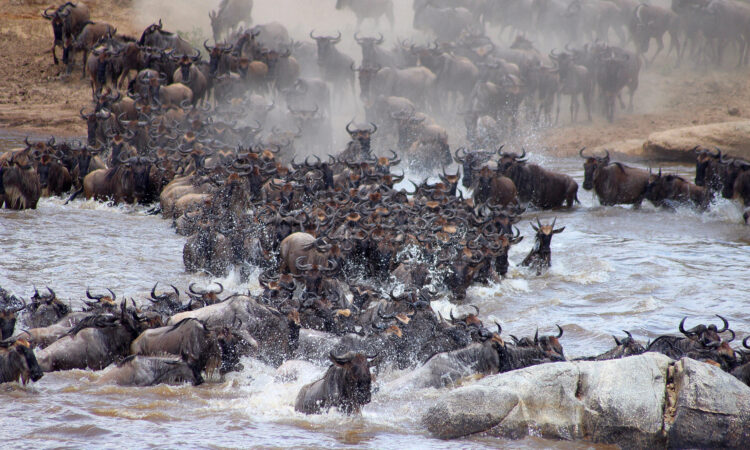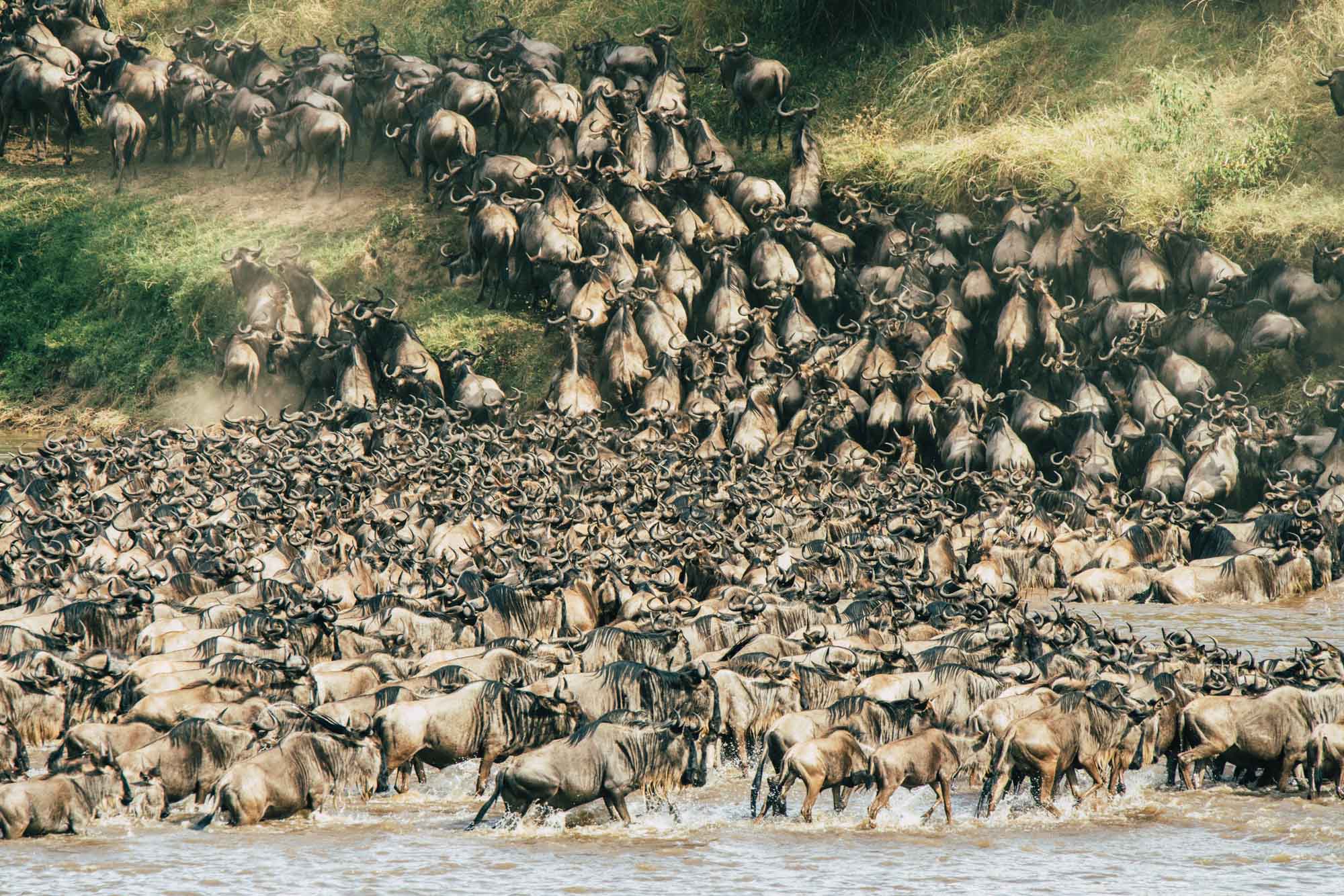Where to see the Wildebeest Migration? The wildebeest migration, dubbed “the greatest show on earth,” involves huge herds of about two million wildebeest, zebras, and gazelles traveling thousands of kilometers in a roughly circular manner from the southern Serengeti to Kenya’s Maasai Mara and back. The migration is a typical safari experience in Africa, attracting travelers all year to view this amazing display.

The herds go through the entire life cycle, from mating to calving to death – frequently in the jaws of their many predators, the crocodiles and large cats, who are themselves maintained by Mother Nature’s magnificent, if harsh, cycle.
This never-ending voyage involves herds separating and reuniting, retracing their steps before continuing on, and other variants that might make the whole affair appear more chaotic than it is. And, while the herds normally follow the rains, it’s impossible to predict when they’ll arrive at each location. The dates and routes vary from year to year, making the exact spot for a migration safari difficult to anticipate.
Staying in a movable safari camp increases your chances of spotting migrating herds because these facilities move seasonally to follow the migration pattern. If you have the time, stay at two or three safari camps in various parts of the Serengeti National Park or the Mara, depending on when you visit.
The stunning river crossings are the most sought-after sights, but planning your entire vacation around them is perilous since the crossings are so unpredictable, and it’s far from assured that you’ll be in the right location at the right time. Consider seeing a river crossing as a bonus rather than the primary purpose for your trip.
Where to see the Wildebeest Migration?
Ngorongoro Conservation Area and the Ndutu Plains.
The distant territory to the south of Serengeti National Park (known as Kusini, or’south’ in Swahili) borders the Ndutu Plains in the Ngorongoro Conservation Area and the Maswa Game Reserve to the southwest, forming a huge stretch of open grassland interspersed by clumps of acacia forest.
Between January and March, the wildebeest migration travels through the Ngorongoro and Ndutu regions. Calving season has arrived, and the herds of wildebeest (along with zebras and gazelles) have swollen to hundreds of thousands of newborn calves.
However, the broad grassland plains and scant tree cover provide an excellent hunting environment for big cats and hyenas, who attack on newborn calves when they are most vulnerable. The marvel of new life and progress is balanced by the brutal reality of the prey-predator relationship, making this a dramatic—and traumatic—time. Lions, leopards, cheetahs, and hyenas may all be found in the area.
The Maswa Game Reserve borders the southern Serengeti, with two private reserves, Maswa Mbono to the north and Maswa Kimali to the south. The reserve is critical to the conservation of the Serengeti environment. Successful anti-poaching operations have increased animal populations, and it serves as an important barrier between the village and the Serengeti National Park, decreasing encroachment and making it more difficult for poachers to enter the Serengeti.
Lake Ndutu, a soda lake (very alkaline and salty), is also nearby and a well-known feeding place for the lesser flamingo. Apart from animal watching, the region boasts some breathtaking landscapes with signs of early human occupation, such as rock drawings on kopjes (rocky outcrops) and Olduvai Gorge, an important archaeological site where some of the oldest hominid bones were discovered in 1973.
Central Serengeti towards the western Corridor
The ‘long rains’ begin in April and the wildebeest wash up through the southern Serengeti where the massive herds separate and stretch out into the middle Serengeti and, eventually, into the ‘western corridor’.
The Seronera River and its adjacent valley are at the center of the national park. The Seronera is a perennial river that provides year-round habitat for animals, including lions, leopards, and cheetahs. Because of the variety of habitats and the year-round availability of water, this area is home to an abundance of herbivores like as zebras, Bohor reedbuck, and Grant’s gazelles. The neighboring Lake Magadi is also home to flamingos.
The environment is littered with enormous kopjes, which are a product of volcanic activity in the area and are popular perches for big cats. The famed ‘gong rocks’ at Moru Kopjes are among these stones, which are said to have been utilized for communication over the wide plains.
There are also caverns nearby that were utilized by the Maasai until about 50 years ago, complete with rock painting. The last remaining black rhinos in the Serengeti may also be found near the Moru Kopjes, south of the Seronera River.

Front runners will reach the western corridor, where they will ultimately meet the Grumeti River, the first significant river crossing for the wildebeest on their long trip north. Although the Grumeti is not as broad or perilous as the Mara, numerous magnificent crossings may be found here.
Northern Serengeti and the Mara River
The herds, still dispersed, move north through the Ikorongo Game Reserve to the Kogatende and Lamai districts on the banks of the Mara River. Between July and October, the Kogatende region in the northern Serengeti is an excellent site to catch the migration, with July and August often being the best months. There is a year-round resident lion pride in the region, as well as additional leopards and cheetahs.
The Mara River, which runs along the extreme northern boundary of the Serengeti National Park, serves as the backdrop for the famous migratory river crossings. During the peak summer months, the Kogatende is an excellent place to base oneself. River crossings happen on a regular basis, and there will be significantly less tourists than in the Maasai Mara, just across the border.
Witness the Wildebeest Migration in Kenya’s Maasai Mara
The Maasai Mara National Reserve (Mara for short) in Kenya comprises the northern rim of the Serengeti ecosystem, the most of which is in Tanzania.
Between June and October, the herds usually migrate through the Mara. The Mara River passes through the reserve’s heart, making area great river crossing territory. During the summer, the herd will be crisscrossing the river in a frenzy, anxiously avoiding the crocodiles hiding beneath the waterline.
The Maasai Mara National Reserve is small in contrast to the Serengeti National Park, yet Kenya is by far the most popular safari destination, thus it may get crowded during peak migration months. In the Mara, there are around 300 camps and lodges ranging from dirty yet affordable to opulent.
Prices per person per night range from $150 to $1,000. You can stay on the reserve itself, but the finest places to stay are in the conservancies that surround it. With such a wide pricing (and quality) range, it’s generally best to book through a trustworthy tour operator company to prevent disappointment.
Witness the Wildebeest Migration in Eastern Serengeti
The eastern Serengeti is a grassland environment broken by acacia trees and rocky outcrops, the most notable of which is Gol Kopjes. This is an excellent location to observe large cats pursuing their prey, such as Grant’s or Thomson’s gazelles.
The herd disperses again in October and November for its lengthy and fast-moving trek south, passing via the Loliondo and Lobo districts. At this time of year, catching the migration is difficult, but there’s lots of other species to see, and low season offers great value at some very stunning lodges and camps.
Beyond the park’s eastern limit is an active volcano known as Ol Doinyo Gol (‘Mountain of God’ in Maasai). It is very tiny in comparison to the famed Kilimanjaro (5,500m), yet it is nonetheless a hard full-day hike.
The lava flows of the volcano have replenished the surrounding grasslands, making it an appealing destination for wildebeest on their way south. Lake Natron, located much farther east, is another soda lake that serves as an excellent breeding habitat for thousands of lesser flamingos.
Which is the Best place to see the Wildebeest Migration?
The Maasai Mara National Reserve in Kenya is a more affordable option for seeing the wildebeest migration. Despite having a shorter migratory season, Kenya offers more flights, more visitors, more competition, and a wider range of economical lodging options than Tanzania.
Because of Tanzania’s vastness, traveling beyond the Northern Circuit usually necessitates domestic flights, therefore visiting the parks in the south and west is more expensive but often considerably more exclusive.
The Serengeti National Park in Tanzania is far larger than the Maasai Mara, having more private hotels and campgrounds in less populated places. Having saying that, the center Serengeti can still get quite crowded, so choosing your camps carefully is essential.
In summary, Kenya is the superior option for family safaris, those on a tight budget, and those with limited time. Tanzania may be your best choice if you want to spend, get away from the throng, and see various destinations.


